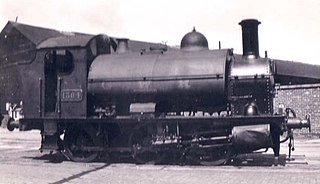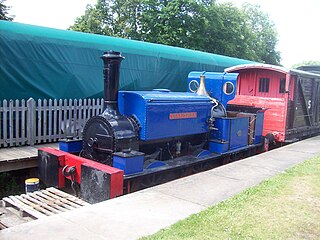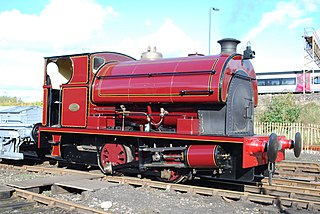Related Research Articles

A Fairlie locomotive is a type of articulated steam locomotive that has the driving wheels on bogies. It was invented by Robert Francis Fairlie. The locomotive may be double-ended or single ended. Most double-ended Fairlies had wheel arrangements of 0-4-4-0T or 0-6-6-0T. All were tank locomotives.

Under the Whyte notation for the classification of steam locomotives, 0-4-0 represents one of the simplest possible types, that with two axles and four coupled wheels, all of which are driven. The wheels on the earliest four-coupled locomotives were connected by a single gear wheel, but from 1825 the wheels were usually connected with coupling rods to form a single driven set.

0-6-0 is the Whyte notation designation for steam locomotives with a wheel arrangement of no leading wheels, six powered and coupled driving wheels on three axles, and no trailing wheels. Historically, this was the most common wheel arrangement used on both tender and tank locomotives in versions with both inside and outside cylinders.

The Hunslet Engine Company is a locomotive building company, founded in 1864 in Hunslet, England. It manufactured steam locomotives for over 100 years and currently manufactures diesel shunting locomotives. The company owns a substantial fleet of Industrial and depot shunting locomotives which are available for hire. The company is part of Ed Murray & Sons Ltd.

The first Locomotives of the Great Western Railway (GWR) were specified by Isambard Kingdom Brunel, but Daniel Gooch was soon appointed as the railway's Locomotive Superintendent. He designed several different 7 ft 1⁄4 in broad gauge types for the growing railway, such as the Firefly and later Iron Duke Class. In 1864 Gooch was succeeded by Joseph Armstrong who brought his standard gauge experience to the workshops at Swindon. To replace some of the earlier locomotives, he put broad gauge wheels on his standard gauge locomotives and from this time on all locomotives were given numbers, including the broad gauge ones that had previously carried just names.

Under the Whyte notation for the classification of steam locomotives, 0-4-2 represents the wheel arrangement with no leading wheels, four powered and coupled driving wheels on two axles and two trailing wheels on one axle. While the first locomotives of this wheel arrangement were tender engines, the configuration was later often used for tank engines, which is noted by adding letter suffixes to the configuration, such as 0-4-2T for a conventional side-tank locomotive, 0-4-2ST for a saddle-tank locomotive, 0-4-2WT for a well-tank locomotive and 0-4-2RT for a rack-equipped tank locomotive.

The 1361 Class were small 0-6-0ST steam locomotives built by the Great Western Railway at their Swindon Works, England, mainly for shunting in docks and other sidings where track curvature was too tight for large locomotives.

Manning Wardle was a steam locomotive manufacturer based in Hunslet, Leeds, West Yorkshire, England.

Londonderry Port and Harbour Commissioners (LPHC) No. 3 R H Smyth is a preserved Irish steam locomotive.

The Avonside Engine Company was a locomotive manufacturer in Avon Street, St Philip's, Bristol, England between 1864 and 1934. However the business originated with an earlier enterprise Henry Stothert and Company.

Peckett and Sons was a locomotive manufacturer at the Atlas Locomotive Works on Deep Pit Road between Fishponds and St. George, Bristol, England.

GWR No. 1340 is an 0-4-0ST steam locomotive, built in 1897 by the Avonside Engine Company of Bristol, England.

The South Devon Railway 2-4-0 locomotives were small 2-4-0T broad gauge locomotives operated on the South Devon Railway, mainly on its branch lines such as that to Ashburton.
During the 1880s and 1890s, William Dean constructed a series of experimental locomotives to test various new ideas in locomotive construction for the Great Western Railway.

The Pallot Steam, Motor & General Museum is a mechanical heritage museum located in Rue De Bechet in the Parish of Trinity on the island of Jersey.

A & G Price Limited is an engineering firm and locomotive manufacturer in Thames, New Zealand founded in 1868.
Powlesland and Mason were a company that provided steam locomotives and crews for shunting within Swansea Docks. The first name has sometimes been spelt "Powesland" and it is uncertain which spelling is correct.
The Bristol and Gloucestershire Railway was an early mineral railway, opened in two stages in 1832 and 1834, which connected collieries near Coalpit Heath with Bristol, at the river Avon. Horse traction was used. It was later taken over by the Bristol and Gloucester Railway, and much of the route became part of the main line between Birmingham and Bristol, though that was later by-passed and closed. Part of it now forms the Bristol and Bath Railway Path.

The Cape Government Railways 0-4-0ST of 1873 was a South African steam locomotive from the pre-Union era in the Cape of Good Hope.
References
- John Bartlett (2004). Images of England, Fishponds
- Mark Smither (1993). Backtrack, The Avonside Engine Company of Bristol, 181-7
- Peter Davies (1994). Backtrack, Avonside Engine Co, 274-8